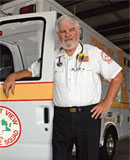Research by day, rescue by night
By Nan Johnson

A trip to Walt Disney World could easily be called a “life-changing” event. Especially for a family of seven like the Diegelmanns. But for Bob Diegelmann, Ph.D., it wasn’t seeing Mickey Mouse at the Magic Kingdom that made such a lasting impression nearly 20 years ago. It was being part of a team that saved the life of an elderly man.
“One afternoon I heard someone scream,” remembers Diegelmann, who was a professor of biochemistry. “I went out on the balcony and saw a man on the ground and thought, ‘I need to help’ so I went down, with no experience except knowing the importance of performing CPR and calling 9-1-1.” A nurse joined him at the scene and the two began CPR. An ambulance arrived minutes later. The gentleman survived, and Diegelmann was moved by the experience. But the basic scientist felt insecure about not knowing what to do in an emergency situation.
Back home in Richmond he enrolled in a CPR class offered by the Forest View Rescue Squad, a volunteer organization serving his community. One thing led to another. He became CPR-certified. Next, he did a “ride along” and spent 24 hours with squad members encountering more than a dozen emergencies from traffic accidents to diabetic seizures to fistfights.
“That was a lot of activity for a 24-hour period and it was definitely an adrenaline rush,” he said.
It wasn’t long before Diegelmann became a certified emergency medical technician and an emergency vehicle operator course instructor. He joined the Forest View Rescue Squad in 1993, applying his skills as a scientific problem solver for 14 years. Today, as a squad retiree, he holds emeritus status as a lifetime member.
Becoming a part of that world was a natural extension of Diegelmann’s professional life. “I’ve always had an underlying interest in trauma and wound healing,” he said. “My classroom teaching, research and my outside interests are all involved. It all kind of melds together.”
Now an internationally recognized leader in wound healing and tissue repair research, Diegelmann is president elect of the Wound Healing Society, a national organization he co-founded in the late 1980s to improve wound healing outcomes through science, professional education and communication. While with the National Institutes of Health in the 1970s, he co-authored a paper that is among the 20 most cited papers in the American Chemical Society’s Biochemistry journal.
In 2001, he met Kevin Ward, M.D., an emergency medicine physician at the medical school, and became a founding member of the VCU Reanimation Engineering Science Center, a multidisciplinary cross-campus collaborative effort among clinicians, basic scientists, engineering and mathematical scientists.
“If basic scientists were left alone, they’d be doing some very esoteric things,” Diegelmann said. “But when you start to work with clinicians, engineers and other nonmedical disciplines, translational projects quickly become reality. It becomes possible to do unique, life-saving science, making science fiction a reality.”
One such project resulted in the invention of a proprietary hemorrhage control product, which received federal approval in 2007. It was endorsed by the U.S. Department of Defense and selected for the Advanced Technology Applications in Combat Casualty Care Award for the increased insight it brought to stopping the life-threatening hemorrhage that accounts for 60 percent of preventable combat deaths.
Such bleeding was not unlike what Diegelmann had seen throughout his 14-year experience as an EMT. “It’s a challenge for a couple of guys to stop the bleeding from gunshot wounds, stabbings or being thrown through a car windshield from an accident,” he said. “You want to help come up with something in the lab to help take care of these problems.”
The product has been reformulated as a nanopowder and is being successfully tested in humans as a means to control life-threatening gastrointestinal bleeding.